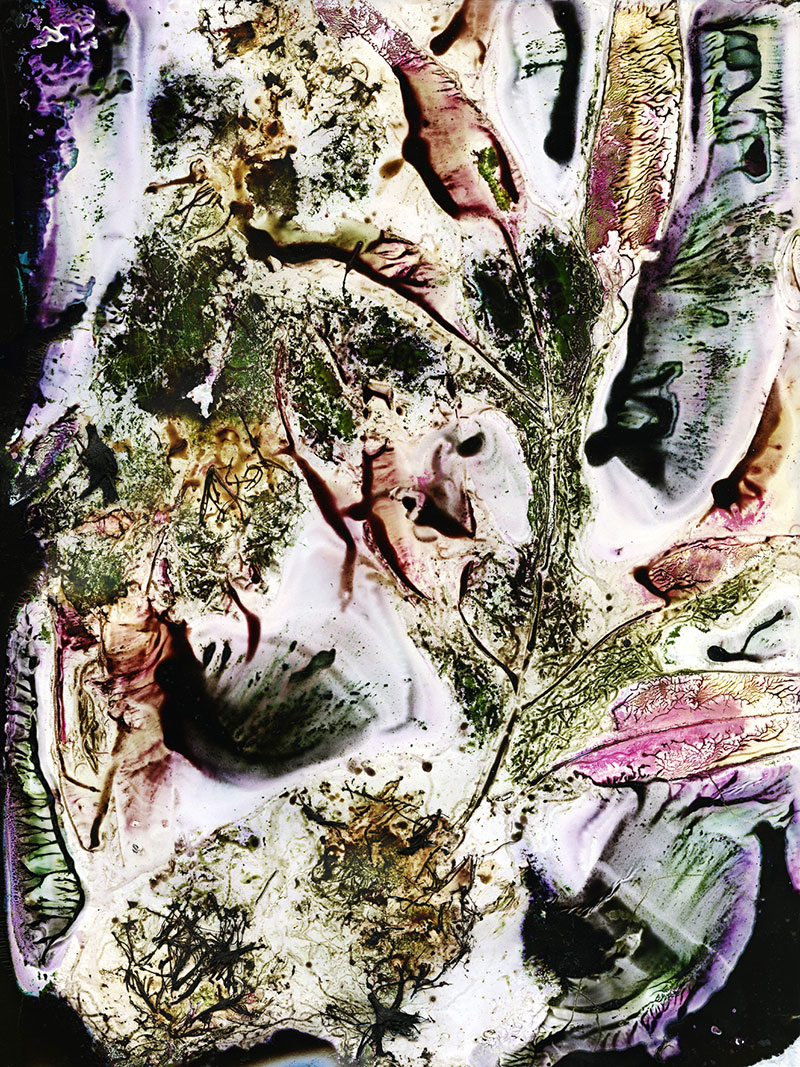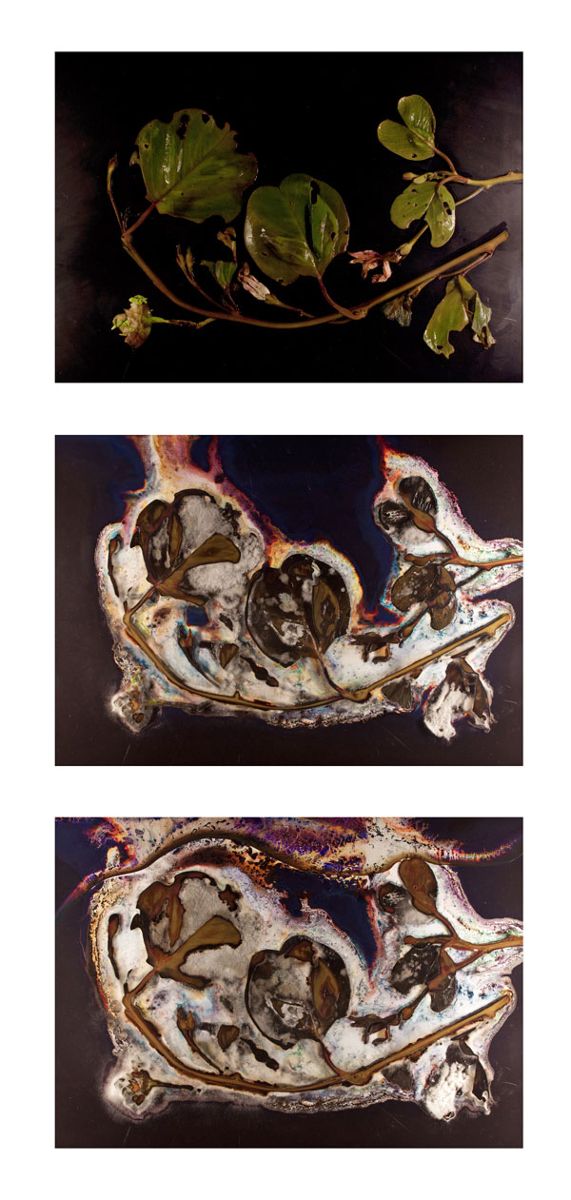
In a post-human world, the dreaming of nature evolves to become one of correlation, interdependence and surreal mutation. Renata Buziak’s exhibition Unfolding Rhythms II exemplifies this transition away from nature as a transcendental, external entity meant simply for reverence and harvesting towards an appreciation of the life cycle of destruction and regeneration.
Her large-scale biochromes initiate aesthetic relationships by combining microbes, plants and chemicals. Photographed after weeks of gestation, each print is defined by organic and inorganic subjects, collaborating as they interact. To begin with, they are messy rebellions pitted against the allure of traditional botanical illustrations. In contrast to squeaky-clean renderings of solitary, passive flora floating on empty white pages, Buziak introduces in each biochrome a community of beings that feed, decay and transform. With a palette coupling the natural earth-tones of plant life and switched-on, saturated hues of analogue photographic materials, she destroys the wall of pictorial elegance imposed by older imaging techniques usually associated with botanical prints.
Buziak, a native of Poland, grew up in a family culture that celebrated the healing properties of plants. She has recently engaged in extensive dialogue with traditional owners on North Stradbroke Island (the Quandamooka People of Minjerribah), just off the coast of Brisbane, in order to work with native plants employed for millennia as medicinals. Simultaneously encoding meaning from both scientific method as well as Indigenous knowledge gained over thousands of years of lived experience, she knowingly exploits photography’s witnessing presence in blurring normative cultural boundaries; in particular, to assert that sharing knowledge systems leads to more profound understanding.

Pteridium (2015) is a close-up image of the effect of Buziak’s biochrome process upon common Austral bracken, an edible understorey genus found throughout most of Australia and New Zealand, traditionally eaten once pounded and heated, known as jurbin in the Jandai language spoken on Stradbroke and Moreton islands. With its icy-blue tonalities and nearly obliterated imagery, Pteridium appears crystalline and ghostlike, somewhat decipherable as the image of a plant, yet conjuring up a bird’s-eye view of snow-covered mountains, complete with lakes and ravines melting into estuaries and rivers. Its visual ebb and flow from micro- to macrocosmic lays down a contrapuntal loop beside the cycles of growth and decline evidenced in degraded pinnae and stems. The visual paradox here is that such a state of destruction can feel so fresh and beautiful. Pteridium invokes a purity and theatrical verity provoking life in death, and death in life.
The time-lapse video entitled Medicinal Plant Cycles, 2012–15 captures the interaction of plants, microbes and chemicals as each transitions from life to dissolution and/or regeneration. Richly coloured and textured, its gentle, multi-centred, rhythmic motion unfolds slowly as chemical processes develop over time: decomposition and fractilisation expose organic necessity; fungi proliferate and organic matter disappears in smears and blobs. Of course, the role of photography in scientific work has been referenced throughout Buziak’s oeuvre. But Medicinal Plant Cycles adds a narrative sound component with voiceovers of recorded dialogues with several Quandamooka people. They recount personal memories and stories related to plants, traditionally included as subjects in everyday life.
This is relational art that strikes out in mysterious directions – more inclusive, for instance, than meals served to gallery goers to focus on bringing people together (as the artist Rirkrit Tiravanija and others have staged). Instead, Buziak introduces aesthetic partnerships across the animal, vegetable and mineral kingdoms, mirroring the universal creative relationships that support survival. The micro-organisms active in the biochrome process parallel those very same bugs in our guts. As the eco-philosopher Timothy Morton has written in Dark Ecology, “… There are more bacteria in ‘me’ than “human” components.”[1] As a meditation on the constant flux of natural processes, Unfolding Rhythms II is a seduction cultivating our curiosity for the terrible beauty of decay - our fascination with mortality in the face of life’s continuity.

Footnotes
- ^ Timothy Morton, Dark Ecology, New York, 2106, p. 18.

